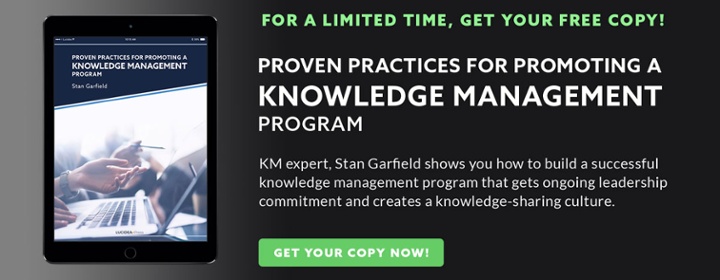
There are many ways to build a positive reputation for knowledge management within your organization. One big and very popular user-focused improvement is to make content easier to find. To do so, provide content in multiple ways and through multiple channels. Read on for some specific suggestions.
Offer these user interface elements:
- Navigation
- Search
- Facets
- Related (since you downloaded X, try Y)
- A-Z Index
- Tags
- Bookmarks
- Sorted by most visited, most liked, most reused, and newest
Offer these channels:
- Intranet sites
- Blogs
- Mobile apps
- Email subscriptions
- Hardcopy subscriptions
- RSS feeds
- ESNs
- Podcasts
- Video
Take advantage of:
- Mobile optimization
- Photos
- Podcasts
- Video
- Hashtags
- External social media such as Twitter, Pinterest, Instagram, SlideShare, etc.
Here are five suggested ways to make useful content easier to find.
- Make the search engine able to limit results by the date of the knowledge object. Defaults can be set to limit results to the last 90 days, one year, or whatever duration is desired. But it should be easy for users to change the date range to include older content in the search results.
- Add an “I reused this document” or “I found this useful” button, similar to a “Like” button but more specific, to all content. Encourage users to click on this button for content they were able to reuse.
- Allow content to be tagged with “recommended” or “good example” or “proven practice” by an authoritative source.
- Allow searching by date, tag attribute, most-liked by users, etc., and display at the top of the results list that content with the most “I reused this document” or “I found this useful” clicks, or the highest number of “recommended,” “good example” or “proven practice” tags by an authoritative source.
- Determine the topics of greatest importance to the organization, curate a list that can be searched and filtered, “pin” them to the top of results lists, and feed them as enterprise search “best bets,” with links to the content deemed to be the best for each key topic.
Beyond organic search results, you can intentionally provide content you know to be useful (option 5 listed above). To do so, determine the topics of greatest importance to the organization, curate a list of relevant content that can be searched and filtered, and feed the entries as enterprise search results. These can be in the form of curated answers: “best bets” (thumbnails and links only), authoritatively-badged content, or quick answers (more complete content plus links) for content deemed to be the best for each key topic. Results can also be dynamically generated using attributes, tags, sorts, filters, human interaction, etc.
Lucidea Press has published my latest book, Proven Practices for Promoting a Knowledge Management Program, which offers advice and insights drawn from my career as a KM practitioner, including more tips on embracing technology to offer a great user experience.



